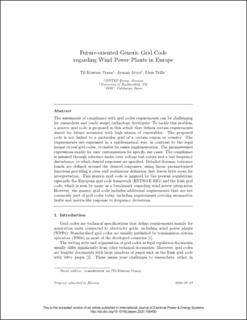| dc.contributor.author | Vrana, Til Kristian | |
| dc.contributor.author | Attya, Ayman | |
| dc.contributor.author | Trilla, Lluis | |
| dc.date.accessioned | 2021-09-27T13:01:00Z | |
| dc.date.available | 2021-09-27T13:01:00Z | |
| dc.date.created | 2020-08-31T13:59:01Z | |
| dc.date.issued | 2021 | |
| dc.identifier.issn | 0142-0615 | |
| dc.identifier.uri | https://hdl.handle.net/11250/2783779 | |
| dc.description.abstract | The assessment of compliance with grid codes requirements can be challenging for researchers and (early stage) technology developers. To tackle this problem, a generic grid code is proposed in this article that defines certain requirements aimed for future scenarios with high shares of renewables. The proposed code is not linked to a particular grid of a certain region or country. The requirements are expressed in a mathematical way, in contrast to the legal format of real grid codes, to enable for easier implementation. The parameterised expressions enable for easy customisation for specific use cases. The compliance is assessed through reference under/over voltage test events and a test frequency disturbance, to which desired responses are specified. Detailed dynamic tolerance bands are defined around the desired responses, using linear parameterised functions providing a clear and continuous definition that leaves little room for interpretation. This generic grid code is inspired by the present regulations, especially the European grid code framework (ENTSO-E RfG) and the Irish grid code, which is seen by many as a benchmark regarding wind power integration. However, the generic grid code includes additional requirements that are not commonly part of grid codes today, including requirements covering asymmetric faults and inertia-like response to frequency deviations. | en_US |
| dc.language.iso | eng | en_US |
| dc.publisher | Elsevier | en_US |
| dc.rights | Attribution-NonCommercial-NoDerivatives 4.0 Internasjonal | * |
| dc.rights.uri | http://creativecommons.org/licenses/by-nc-nd/4.0/deed.no | * |
| dc.title | Future-oriented Generic Grid Code regarding Wind Power Plants in Europe | en_US |
| dc.type | Peer reviewed | en_US |
| dc.type | Journal article | en_US |
| dc.description.version | acceptedVersion | en_US |
| dc.source.volume | 125 | en_US |
| dc.source.journal | International Journal of Electrical Power & Energy Systems | en_US |
| dc.identifier.doi | 10.1016/j.ijepes.2020.106490 | |
| dc.identifier.cristin | 1826248 | |
| dc.source.articlenumber | 106490 | en_US |
| cristin.ispublished | true | |
| cristin.fulltext | postprint | |
| cristin.qualitycode | 1 | |

